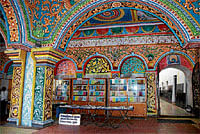
We sighed collectively, as we peered at the manuscripts and miniature art works arranged under glass cases in the museum at the Thanjavur Maharaja Serfoji’s Saraswati Mahal Library. We tried to decipher the tiny script — in Sanskrit, Telugu, Marathi — and view the details on the miniature paintings and artefacts.
The museum offers a glimpse of the vast variety you might see in the library. So there were books and palm-leaf manuscripts, paper paintings, glass paintings, physiognomy charts, astrology scrolls, exquisitely inlaid ivory art, atlases, wooden paintings, etc. Some manuscripts showed only printed matter while the rest were richly illustrated.
We went around checking out the displays, as a stately and benign-looking Serfoji looked down at us from large portraits installed in the corners. The Thanjavur-style paintings, miniature Ramayana, and the Ashva and Gaja Shastra depictions were fascinating. There were also explicit pictures of Chinese torture — including one for bad translation! Less likely to induce nightmares were the displays on their left — music books with musical notations clearly visible — saa, ri, ga, maa, dha...
Actually, the displays here are only a small fraction of the library’s treasures. There is a total of about 60,000 volumes in the famed Library — including those on palm-leaf and paper. They are on subjects like music, dance, geography, history, science including medicine (like Vaidyarathnavali), philosophy, literature including prose and poetry, cuisine (like Sarbhendra Paka Sastra), and lexicons too.
The books and palm-leaf manuscripts are in English, Sanskrit (some of them written in different scripts like Grantha, Telugu, Devanagari, etc), Tamil, Telugu, Marathi and a few in Persian and Urdu. One of Asia’s oldest libraries, it is located within the Thanjavur Nayak Palace complex in Tamil Nadu’s Thanjavur, and was built by contributions of successive dynasties of Nayaks and Marathas of Thanjavur. It is now certified as an Institution of National Importance and has an interesting history.
In ancient and medieval India, rare manuscripts and artifacts were in the possession of individuals like scholars, priests, and nobles, and also in organisations like temples and mutts. And virtually every king had his private library generally referred to as the Saraswati Bhandar.
This Saraswati Mahal Library was one such private collection of the Nayak kings of Thanjavur (1535 to 1675). This region was later captured by the Marathas and they also contributed greatly to its store (1676-1855). After the death of the last Maratha queen followed by much litigation, the library finally came under the Tamil Nadu government.
Initially known as the Royal Palace Library, it was later rechristened as the Thanjavur Maharaja Serfoji’s Saraswati Mahal Library as a tribute to Serfoji’s contribution to making it such a treasure trove. Serfoji (1798-1832) was a man of great learning, a great art lover, avid reader and an international traveller for someone of his time. Besides engaging pandits to gather valuable books, he personally picked up valuable books and artifacts from his worldwide travels.
The library has also been enriched in the past few decades by persons who have donated ancient palm leaf manuscript or rare books in their possession, which they are unable to care for anymore. Some individuals have donated their entire and substantial private collection, while a few persons have given just one or two dusty manuscripts lying with their family for generations, without them having a clear idea of its exact history or value.
The Sanskrit works are a remarkable part of the library collection and cover both art and science. There are also many manuscripts in the Modi script which was used for official correspondence from the 12th century. When Marathi became the court language, the court’s scribes had to record court orders in the language. Necessity, therefore, became the mother of the invention of a ‘short-hand Marathi’ i.e. Modi. These Modi records — nearly 3,000 — include those about land grants, legal rulings, chathrams (wayside resthouses) and routine communication.
There are compositions by Shahaji (1684—1712) who was a prolific padam-composer and who also wrote a Marathi dance-drama. The Tamil works include medical books; commentaries on Sangam works; besides Saiva, Vaishnava and Jain works. Telugu works contain prabandhas, dwipada kavyas and pada kavyas besides those on classical music.
Of great use to researchers is the Library’s Reprography Section with its microfilming unit installed in 1980.
In the first phase, about 5,000 of the rarest manuscripts were chosen for microfilming. However, it would be wonderful if the entire library collection could be digitised and made available online in a comprehensive website. The library is actually a designated Manuscript Conservation Centre under the National Mission for Manuscripts.
However, it’s only a reference library — books and documents are not lent. Bonafide scholars can receive copies of books and benefits of other services rendered by the library — like transcription, transliteration, and consultation.
The library is part of the Thanjavur Palace Complex and next door is a fabulous art collection. A large tower at this art gallery allows visitors to go up and get a bird’s eye view of the entire town.
The Raja Serfoji Memorial Hall and adjoining rooms were fascinating — a large impression of the king himself on an elevation and a fabulous collection of (mostly) bronze statues, besides ancient coins dating from the second century. And they were all well displayed with clear name plates and arrayed with enough space between them — not crowded together as at some other Indian museums.
The paintings of the great Carnatic music trinity — Thyagaraja, Shyama Shastri and Mutthuswami Dikshitar — were in a room with fewer displays. The last time I came to this palace was, several years ago, during a break from the Thiruvayyaru Thyagaraja Aradhana and the entrance has been renovated and the rooms have been spruced up a great deal, I noticed.